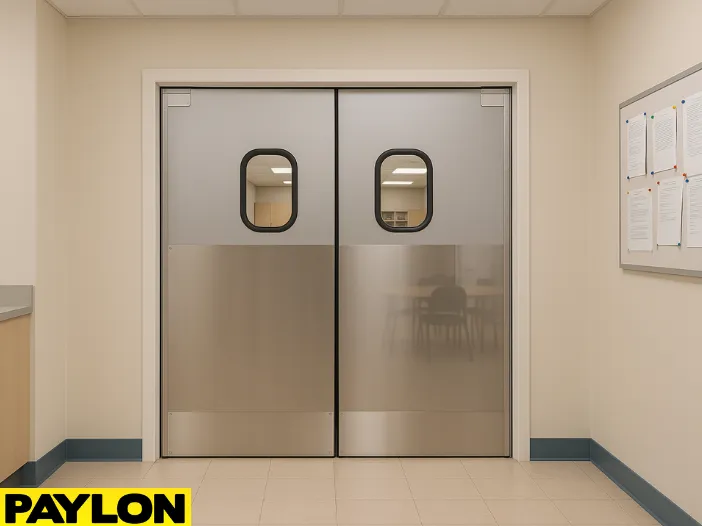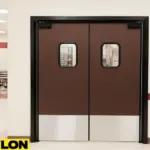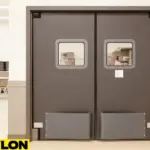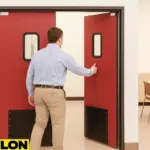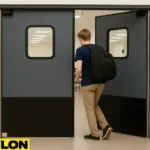School Swinging Doors
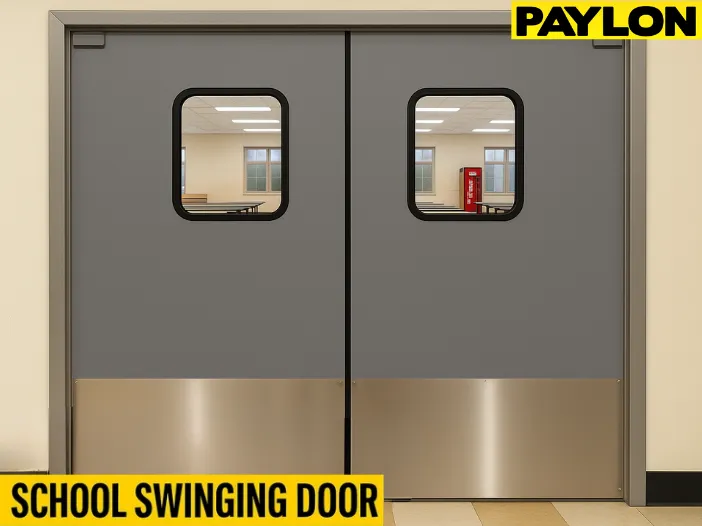
Crowded cafeterias, noisy lounges, and hygiene risks slow things down. This guide explores how double-swinging doors help improve foot traffic, safety, and cleanliness. You’ll discover which door models fit each school zone best, compare key features side by side, and learn how to choose the right one for your school’s needs.
Built for School Safety & Efficiency
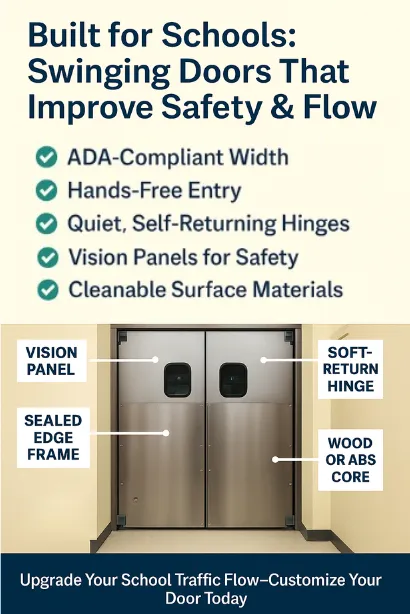
From bustling cafeterias to quiet teacher lounges, these school swinging doors are built to handle it all. With safety vision panels, and hands-free operation, they make every transition cleaner, safer, and quieter. Whether you're upgrading old doors or planning a new facility, this quick checklist helps you choose models that work best for education spaces. Take control of foot traffic and customize a door that supports your school’s needs, now and for years to come.
Why Schools Choose Swinging Doors for Busy Zones
Not all school doors are built to keep up with daily student movement. When hundreds of people are passing through high-traffic areas like cafeterias, teacher lounges, and supply zones, you need doors that help, not hinder, your building’s flow. That’s where well-designed swinging doors make all the difference.

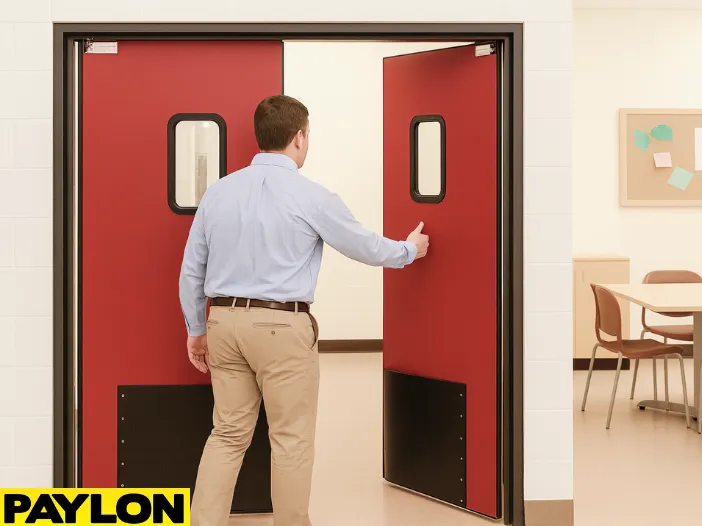
Built for Everyday School Movement
Helps Keep Hallways Clear
During busy transitions like class changes and lunch periods, swinging doors help reduce hallway congestion. Their double-action swing allows students and staff to move through from either direction without waiting, which keeps foot traffic flowing smoothly between spaces.
Closes Quietly and Works for Everyone
With built-in self-return hinges, these doors close softly behind each person, helping reduce noise in already active school environments. They're also ADA-compliant, giving students, staff, and visitors easy access no matter the time of day or type of traffic.
Designed to Handle Real-World Wear and Tear
Built to Withstand Daily Wear
In a typical school day, doors are hit with everything from backpacks to cleaning carts. That’s why swinging doors are made with reinforced surfaces that resist dents, scuffs, and other signs of heavy use. They’re built to hold up in the busiest zones of your building.
Easy to Clean, Easy to Maintain
Schools need doors that look clean and stay clean. Swinging doors use smooth, low-maintenance materials that make daily sanitation quick and efficient. Whether installed at a cafeteria entrance or outside a staff room, they support your school’s routines without adding extra work.
Find the Right Fit for Each Zone in Your School
Now that you’ve seen how swinging doors improve movement, reduce maintenance, and support daily routines, it’s time to explore the models designed for specific school spaces. This mini buyer’s guide covers four high-performing options, each built to meet the demands of cafeteria entrances, staff lounges, and prep areas.
Cafeteria doors handle some of the highest traffic volumes in any school. The PE 620ALC is built specifically for that challenge, combining strength, visibility, and cleanability into one efficient design.
• Large acrylic vision panels let students and staff see who's coming through
• Aluminum-reinforced edges offer added impact resistance without making the door too heavy
• Smooth outer surfaces allow for quick disinfecting between meal periods
• Durable construction holds up against food carts, trays, and daily rushes
• Self-closing hinges keep traffic flowing and reduce the risk of slamming
When you need a compact door that still offers reliability and resilience, the PE 710 fits the bill. It’s designed for smaller break rooms, shared spaces, and low-to-moderate foot traffic areas.
• Slim door profile fits tighter frames in compact lounge layouts
• Durable thermoplastic face sheets resist chips and scratches from bags or carts
• Hands-free swing gives teachers and staff easy access during busy schedules
• Optional locking features support privacy where needed
• Low-maintenance hardware reduces long-term service demands
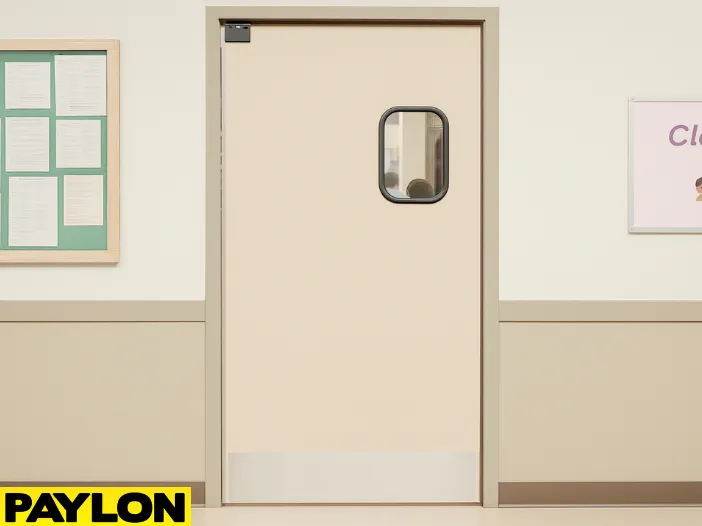
The PE 720 is ideal for doorways connecting staff lounges to main corridors. It balances durability with comfort and appearance, essential for professional, semi-private spaces.
• Full-height bumpers defend the door from rolling carts and janitorial equipment
• Mid-sized vision windows allow safe two-way visibility in busy hallways
• Quiet-return hinge system minimizes noise during open and close
• Clean ABS or wood-core finish blends into modern staff room designs
• Reliable performance makes it ideal for all-day transitions between zones

PE 8000 – Built for Prep Rooms and Utility Areas
Behind the scenes, utility and prep areas demand rugged performance. The PE 8000 is made to handle harsh environments where durability, hygiene, and efficiency matter most.
• Insulated and reinforced core withstands repeated impact from carts or equipment
• Stainless-steel kick plates protect the lower portion of the door from wear
• Sealed surfaces resist moisture and are easy to sanitize after spills or cleaning
• Perfect for kitchen access, custodial zones, and utility corridors
• Heavy-duty hinges allow safe operation even with fully loaded carts
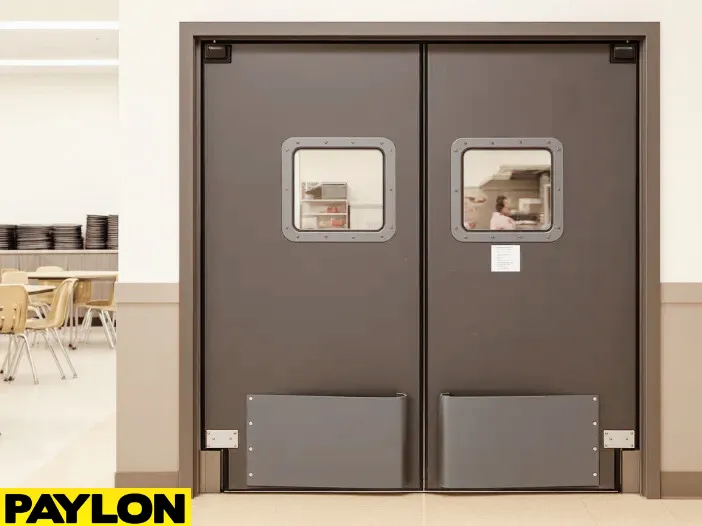
Low Maintenance, Long-Term Value
When choosing doors for schools, durability isn’t the only consideration, maintenance costs and long-term reliability matter just as much. These swinging doors are designed to hold up for years without becoming a burden on your budget or staff.
| Feature | Why It Matters in Schools |
|---|---|
| ✅ Wipe-Clean Surfaces for Daily Sanitation | Smooth finishes like ABS and thermoplastic allow custodial staff to easily disinfect doors throughout the day, especially helpful for maintaining cleanliness between class changes or lunch periods. |
| ✅ Fewer Moving Parts, Fewer Repairs | These doors are designed with minimal mechanical hardware to reduce wear and tear, lowering the chances of mid-year breakdowns or maintenance delays. |
| ✅ Long Lifespan with Reinforced Design | Kick plates, durable edges, and impact-resistant cores make these doors last longer, even in zones that experience heavy backpack traffic or equipment use. |
| ✅ Helps Reduce Accidents in Hallways | Vision panels and soft-close hinges make it easier to see who’s coming and going, minimizing the risk of hallway collisions and improving safety for students and staff. |
These long-term benefits don’t just save money, they simplify operations and support a better environment for everyone in the building.
Find the Right Door for Your School
With multiple door models available, it helps to see how they stack up side by side. This table gives you a quick way to compare key features, so you can confidently match the right swinging door to each part of your school. Whether you're replacing old doors or designing new spaces, use this as a planning guide for smoother, safer foot traffic.
| Door Model | Best Use Case | Material | Window Size | Impact Protection | Return Motion | Bonus Features |
|---|---|---|---|---|---|---|
| PE 620ALC | Cafeteria entrances | Wood core with aluminum edges | 9×14 in acrylic | Stainless steel kick plates | Gravity self-return | Great for food traffic flow and daily sanitation |
| PE 720 | Lounge-to-hallway transitions | ABS or wood core | 9×14 in acrylic | Full-height bumpers | Soft-return hinge | Quiet operation and staff-friendly design |
| PE 710 | Teacher lounges and staff rooms | Polymer honeycomb with PVC frame | 14×16 in acrylic | Thermoplastic face with edge cap | Gravity self-return | Slim build and optional privacy locks for shared spaces |
| PE 8000 | Prep rooms and utility areas | Insulated core with plastic facing | Optional (custom) | Reinforced core and stainless plates | Heavy-duty hinge | Withstands high-impact zones like kitchens and custodial areas |
No two school zones operate the same way, which is why comparing door features side by side can help you plan with more precision. Whether you’re managing a high-traffic cafeteria or a quieter lounge space, this table makes it easier to visualize what fits where, so you can make informed upgrades that support both function and flow.
Frequently Asked Questions
FAQs – Swinging Doors in Schools: What You Need to Know
Which swinging door is best for a school cafeteria?
For high-traffic cafeteria zones, the PE 620ALC cafeteria swinging door is a top pick. Its wood core with aluminum edges offers strength, while acrylic vision panels improve visibility between food prep areas and dining zones. With stainless steel kick plates and gravity self-return hinges, it supports smoother meal transitions and daily sanitation. If you want a door that handles constant flow, consider choosing the PE 620ALC for your cafeteria entrance.
Can school swinging doors be customized with our school colors or logos?
Yes, models like the PE 720 lounge-to-hallway door and PE 710 staff room swinging door are available in a range of finishes and color options. You can request customization to match your school’s branding or create a cohesive look across teacher lounges and cafeteria entrances. Logos, privacy windows, and edge trim styles can also be tailored to your needs.
Do swinging doors for schools meet ADA and fire safety codes?
Absolutely. Doors such as the PE 710 teacher lounge door and the PE 620ALC cafeteria model are ADA-compliant and designed to meet applicable fire and safety codes. These school-use doors include features like hands-free operation, proper clearance widths, and optional privacy locking hardware to support accessibility and safety in every zone.
Are swinging doors noisy when they close?
Not at all, models like the PE 720 hallway-to-lounge swinging door are designed with soft-return hinge technology that ensures quiet operation. Even the PE 620ALC and PE 710 models use gravity self-return mechanisms that reduce slamming. These doors are built to support learning environments where noise control matters, such as teacher lounges and cafeteria transitions.
How long do school swinging doors typically last?
Durable options like the PE 8000 utility area swinging door are built for longevity, even in high-impact environments like food prep zones or custodial areas. With reinforced cores and impact-resistant features, many models last for 10+ years with minimal upkeep. For schools looking to reduce future maintenance costs, choosing doors like the PE 8000 or PE 620ALC is a smart investment.
Which door works best for teacher lounges and staff rooms?
The PE 710 staff room swinging door is a compact, durable solution made specifically for low-to-moderate traffic zones. It’s ideal for teacher lounges thanks to its slim frame, thermoplastic face, and optional locking hardware for shared spaces. You can request this model with soft-close hinges and vision panels to maintain quiet and privacy.
Can I install the same swinging door model in different school zones?
You can, but it’s best to match each model to its zone. For example, the PE 8000 school prep room door is perfect for utility areas but might be too heavy for lounge use. Meanwhile, the PE 720 is better suited for hallway transitions. Consider choosing models based on their specific features, like kick plates or hinge types, to match usage needs across your campus.
Do these doors support daily sanitation routines in food prep areas?
Yes. The PE 620ALC cafeteria swinging door and PE 8000 prep zone door both feature smooth, non-porous surfaces that can be wiped down easily. Stainless steel kick plates and sealed edges help maintain hygiene in kitchens and dining areas. For schools focused on sanitation, these models are a solid choice.
What’s the benefit of using doors like the PE 720 between hallways and staff rooms?
The PE 720 lounge-to-hallway door reduces hallway noise, protects against cart traffic, and blends well with modern staff room designs. Its ABS or wood core provides resilience, while the soft-return hinge system keeps door movement quiet and controlled, ideal for semi-private spaces with frequent movement.
Are school swinging doors easy to install?
Most models, including the PE 620ALC and PE 710, come pre-drilled and ready for standard frame installations. While professional help is recommended, many schools report fast installation times, especially when upgrading older cafeteria or lounge doors.
Do these doors work well in utility and custodial areas?
Definitely. The PE 8000 school prep room swinging door is built specifically for high-abuse zones like custodial closets, kitchen access points, and maintenance corridors. It features a reinforced insulated core, heavy-duty hinge system, and moisture-resistant surface for long-term durability.
Are vision windows standard in all school swinging doors?
Most models, like the PE 720 and PE 620ALC, come standard with 9×14 inch acrylic windows. The PE 710 features a slightly larger 14×16 inch option, while the PE 8000 offers window customization depending on your privacy or visibility needs. Clear windows are ideal for safety and collision prevention in food prep and hallway zones.
What kind of maintenance do these doors need?
Low. Doors like the PE 710 and PE 8000 are designed with fewer moving parts and resilient surfaces, so they require minimal maintenance. A regular wipe-down and hinge check are usually all that’s needed. For long-term value, consider models that are impact-resistant and corrosion-proof.
Can school doors swing both ways?
Yes. All models, including the PE 720, PE 710, and PE 620ALC, use double-action hinges, which allow for both inward and outward swing. This is especially helpful in school cafeterias, teacher lounges, and narrow corridors where students and staff move through from both sides.
Do these doors help reduce hallway collisions during class changes?
They do. Vision panels and bi-directional swing make doors like the PE 720 and PE 620ALC ideal for reducing congestion during class transitions. Their quiet closing motion and high visibility allow students and staff to pass safely and smoothly.
What’s the difference between gravity and soft-return hinges?
Gravity hinges (found in PE 620ALC and PE 710) use weight to return the door to center, making them durable and low maintenance. Soft-return hinges (used in the PE 720) reduce closing noise, great for quieter zones like teacher lounges. Choose based on the environment’s noise level and door usage.
Can these doors be used in multipurpose rooms or gym access points?
Yes. The PE 8000 and PE 620ALC work well in athletic zones due to their impact resistance and moisture tolerance. They support everything from equipment movement to heavy foot traffic, ideal for gyms, storage rooms, and adjacent locker zones.
Do they come in standard sizes?
Most swinging doors like the PE 710, PE 720, and PE 8000 are available in standard widths and heights but can also be custom-sized to fit your existing frames. For older buildings or non-standard openings, you can request sizing adjustments for a perfect fit.
Are these doors energy-efficient?
Yes. Models like the PE 8000 include insulated cores that help regulate temperature, especially helpful in food prep areas and custodial rooms where climate control is essential. Energy efficiency can also reduce HVAC strain during extreme seasons.
How do I request a quote or learn more about these school doors?
If you're considering upgrading your school’s doors, you can request a quote or product details for any model, whether it’s the PE 620ALC cafeteria swinging door, PE 710 for staff rooms, PE 720 for hallway connections, or PE 8000 for utility areas. Just reach out with your space dimensions and traffic requirements.
Photo Gallery
Improve Flow, Safety, and Cleanliness Starting Today
Every school has unique flow challenges, from midday meal rushes to staff-only access zones. The key is choosing swinging doors that solve those challenges efficiently. Ready to improve movement, hygiene, and safety across your campus? Browse Paylon’s school door collection or get a quote tailored to your layout.

